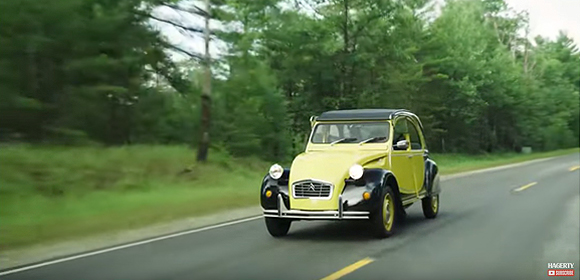Hagerty Posts a 2CV Experience – but Not a Buyer’s Guide

Yesterday, Hagerty posted a YouTube video by journalist Sam Smith where the video’s description claims to show “what makes the Citroën 2CV such a wonderfully strange car to own and tells you everything you need to know about buying, owning, and loving this unique car.”
Yes, the video is entertaining and Sam gets the spirit of 2CV ownership correct, but his advice and knowledge of the car is way off from making the video a definitive guide to purchasing one.
For starters, the video is bizarre as at least 2 cars are shown. Look carefully and you will notice that most of the wide driving shots show a right-hand-drive 2CV, but the interior dialogue shots are done in left-hand-drive one.

The car shown on the hoist has an after-market galvanized frame. It might have been useful to point that out and explain about a the factory original.
Now for the errors stated:
- The headlights adjust by rod not by cable.
- The later (large) engine in a 2CV is not 675 cc but rather 602 cc.
- 2CV’s were built throughout the entire 1980’s not just into the 80’s. The last 2CV rolled off the assembly line on July 27, 1990.
- Prior to the shock absorbers (what Sam refers to as dampers) on later cars, 2CVs used an ingenious weighted coil cylinder mounted near each wheel. There was no friction damper as stated.
The buyer’s guide advice was minimal at best, and pretty much wrong — saying first and foremost – be concerned about the body. Sorry Sam… Frame first, body second on a 2CV. Without a solid frame, you could be driving a death trap. Sam is correct in saying don’t buy a rusty body but then he goes on the say that 2CV’s don’t wear out mechanically and don’t worry about their mechanical condition. Well, indeed they do wear mechanically and either a tired 2CV or rusty body can be an expense where fixing either, let alone both, will quickly escalate to more than what you paid for the car.
The Hagerty video is a very light on accuracy and information needed to properly assess a 2CV. The last shot shows Sam pushing his 2CV along the road after it broke down, which it is pretty much the appropriate outcome for the advice he provides.
If you want to understand 2CV’s and get a decent one, Citroënvie is a great source of info and a means to contact with vendors that can provide decent ones at good value.
UPDATE – Feb. 4, 2021: Subsequent to the video Hagerty posted on January 31, 2021, on February 3, 2021, Hagerty posted this article written by Sajeev Mehta with assistance from Ronan Glon, titled “Your handy Citroën 2CV (1948–90) buyer’s guide”. https://www.hagerty.com/media/buying-and-selling/handy-citroen-2cv-buyers-guide/?utm_source=SFMC&utm_medium=email&utm_content=21_February_5_Newsletter_NewDD
Though it glosses over the importance of starting with a good frame, mentions that 2CVs have removable radios (which they don’t unless they were installed after-market), and doesn’t go into detail about the unique features found on the US spec models that were originally sold over here, the article contains an excellent history of the 2CV and gives good advice for those looking to acquire one.
The one thing that comes across in the piece is a lack of understanding how a 2CV should drive, particularly engine performance. They state that when test driving a 2CV “see if the engine is healthy enough to accelerate reasonably quick up to 10-20 mph (after that you can’t expect much from a 2CV, anyway)”‘. A late model 602 cc engine 2CV should be able to accelerate reasonably quick up to 40 mph, and while beyond that in a more leisurely fashion — attain a top speed of at least 70 mph.
Also, it doesn’t address those 2CVs that reside in North America, having been cleverly aged to conform import regulations at the time. That toipc was covered in this Citroenvie article: https://citroenvie.com/how-new-2cvs-were-aged-for-sale-in-north-america/

His breakdown had all the symptoms of a bad ignition coil – at the beginning I was wondering why he’s revving the engine so much while going at moderate speed on a flat road. Well done for spotting that there’s a second car, in right hand drive, used in the shoot! Re rust: I agree that the frame warrants inspection first and foremost, but when comparing the cost between replacing the frame or the lower body shell, the frame is probably the cheaper job. Most of the late cars with really bad frame problems had them replaced years ago… Certainly not a good idea to buy one with serious rust on both lower body and the chassis!